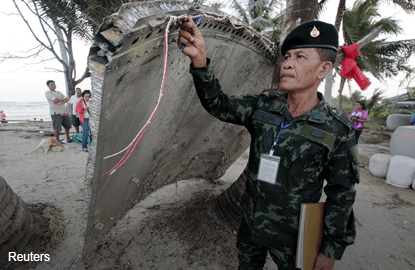
KUALA LUMPUR (Jan 26): A metal panel that washed up on the Thai coast is "likely" to be from a rocket, a Japanese manufacturer said Monday, pouring cold water on speculation it comes from a missing Malaysian Airlines jet.
The claim came as Thai air force experts transported the large 3x4m panel from southern Nakhon Si Thammarat province in the Gulf of Thailand to Bangkok for examination.
Saturday's find of the heavy, curved piece of debris stirred intense media speculation that it may be part of MH370, the ill-fated Malaysia Airlines flight that vanished on March 8, 2014 with 239 people on board.
It had left Kuala Lumpur and was destined for Beijing.
"The next step is to check, analyse and prove what (the debris) is," Air vice-marshal Pongsak Semachai, the Thai Air Force's spokesman, told AFP yesterday.
But that task appeared significantly easier yesterday afternoon after Japanese firm Mitsubishi Heavy Industries said widely circulated images featuring serial numbers indicated it may be from one of their rockets.
"Although we cannot yet be absolutely certain, we think it is likely that it's part of either an H-IIA or H-IIB rocket," Sayo Suwashita, a Mitsubishi Heavy Industries spokeswoman in Tokyo, told AFP.
The rockets are launch vehicles often used to send satellites into space.
The company reached that initial conclusion "after comprehensively examining information such as the shape of the debris and the numbers seen on it."
That backs up experts on sea currents who said a piece of the MH370 was highly unlikely to be found in the Gulf of Thailand.
Aviation investigators believe the plane went down in a remote part of the Indian Ocean.
Last July a 2m long wing part known as a flaperon washed up on a beach on the Indian Ocean island of Reunion. The island is several thousand kilometres southwest of Thailand.
Unlike Reunion, the Gulf of Thailand is not in the path of ocean currents from the supposed crash site.
Nothing has been found since the Reunion discovery, despite a search which has so far covered more than 80,000sq km of the seabed.